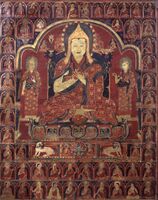Tsong kha pa
Jump to navigation
Jump to search


The printable version is no longer supported and may have rendering errors. Please update your browser bookmarks and please use the default browser print function instead.
ཙོང་ཁ་པ་
| Wylie | tsong kha pa |
|---|---|
| English Phonetics | Tsongkhapa |

Line Drawing by Robert Beer Courtesy of The Robert Beer Online Galleries

Tsongkhapa Himalayan Art Resources
Other names
- ཙོང་ཁ་པ་བློ་བཟང་གྲགས་པ་
- བློ་བཟང་གྲགས་པའི་དཔལ་
- བློ་བཟང་གྲགས་པ་
- tsong kha pa blo bzang grags pa
- blo bzang grags pa'i dpal
- blo bzang grags pa
Dates
| Birth: | 1357 |
|---|---|
| Death: | 1419 |
| Place of birth: | tsong kha (Amdo) |
Tibetan calendar dates
| Day | |
|---|---|
| Month | |
| Gender | Female |
| Element | Fire |
| Animal | Bird |
| Rab Jyung | 6 |
| Day | |
|---|---|
| Month | |
| Gender | Female |
| Element | Earth |
| Animal | Pig |
| Rab Jyung | 7 |
About
- Religious Affiliation
- Geluk
- Primary Professional Affiliation
- Ganden Monastery
- Teachers
- bsod nams rgyal mtshan · Red mda' ba gzhon nu blo gros · Nya dbon kun dga' dpal · Phyogs las rnam rgyal · sgra tshad pa rin chen rnam rgyal · Karmapa, 4th
- Students
- 'dul 'dzin grags pa rgyal mtshan · 'gos lo tsA ba gzhon nu dpal · 'jam dbyangs chos rje bkra shis dpal ldan · mkhas grub rje · Rgyal tshab rje dar ma rin chen · spyan nga bsod nams bzang po
Other Biographical info:
- Assumes office 1409 dga' ldan dgon (stag rtse rdzong)
- Leaves office 1419 dga' ldan dgon (stag rtse rdzong)
- Founds monastery 1409 dga' ldan dgon (stag rtse rdzong)
- Final Ordination 1381 yar klung rnam rgyal dgon
Links
- BDRC Link
- https://www.tbrc.org/#!rid=P64
- Treasury of Lives Link
- http://www.treasuryoflives.org/biographies/view/Tsongkhapa-Lobzang-Drakpa/8986
- Treasury of Lives Excerpt
- Tsongkhapa Lobzang Drakpa was one of the most influential Tibetan Buddhist scholars of the last millennium. Born in Amdo, he travelled to U-Tsang in his youth, never to return to his homeland. In U-Tsang he studied with numerous teachers of all traditions and engaged in many retreats resulting in his development of a fresh interpretation of Nāgārjuna's Madhyamaka view and a reinvigoration of the monastic Vinaya. Widely regarded as an emanation of Mañjuśrī, Tsongkhapa composed eighteen volumes of works of which the majority dealt with tantric subjects. He was the founder of Ganden Monastery, which became the central monastery of the Geluk tradition that was founded on his teachings and writings.
- Himalayan Art Resources Link or Other Art Resource
- https://www.himalayanart.org/search/set.cfm?setID=197
- Wiki Pages
Buddha Nature Project
- Person description or short bio
- Tsongkhapa Lobzang Drakpa was one of the most influential Tibetan Buddhist scholars of the last millennium. Born in Amdo, he travelled to U-Tsang in his youth, never to return to his homeland. In U-Tsang he studied with numerous teachers of all traditions and engaged in many retreats resulting in his development of a fresh interpretation of Nāgārjuna's Madhyamaka view and a reinvigoration of the monastic Vinaya. Widely regarded as an emanation of Mañjuśrī, Tsongkhapa composed eighteen volumes of works of which the majority dealt with tantric subjects. He was the founder of Ganden Monastery, which became the central monastery of the Geluk tradition that was founded on his teachings and writings.
Expand to see this person's philosophical positions on Buddha-nature.
| Is Buddha-nature considered definitive or provisional? | |
|---|---|
| Position: | |
| Notes: | |
| All beings have Buddha-nature | |
| Position: | |
| If "Qualified", explain: | |
| Notes: | |
| Which Wheel Turning | |
| Position: | Second Turning |
| Notes: | Wangchuk quotes mkhas grub rje as stating, "In our system, Jé Rinpoché (rje rin po che, that is, Tsongkhapa) mentions that the Uttaratantra primarily comments on the meaning of those sutras that are in conformity with the middle-wheel teachings, such as the Tathāgatagarbhasūtra, Samādhirājasūtra, Jnānālokasūtra, Aṅgulimālāsūtra, Śrīmālādevīsūtra, and so forth." Wangchuk, Tsering, The Uttaratantra in the Land of Snows, p. 89. |
| Yogācāra vs Madhyamaka | |
| Position: | Madhyamaka |
| Notes: | Note that Wangchuk maintains that he developed this certainty later in his career.
|
| Zhentong vs Rangtong | |
| Position: | Rangtong |
| Notes: | |
| Promotes how many vehicles? | |
| Position: | |
| Notes: | |
| Analytic vs Meditative Tradition | |
| Position: | |
| Notes: | |
| What is Buddha-nature? | |
| Position: | Tathāgatagarbha as the Emptiness That is a Non-implicative Negation (without enlightened qualities) |
| Notes: | |
| Svātantrika (རང་རྒྱུད་) vs Prāsaṅgika (ཐལ་འགྱུར་པ་) | |
| Position: | Prāsaṅgika (ཐལ་འགྱུར་) |
| Notes: | Wangchuk cites Tsongkhapa's students and commentators on this issue:
|
| Causal nature of the vajrapāda | |
| Position: | |